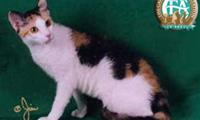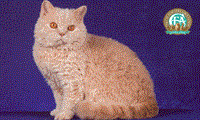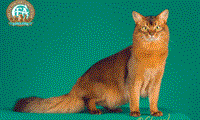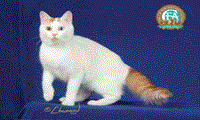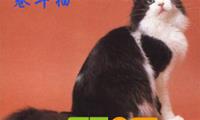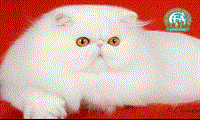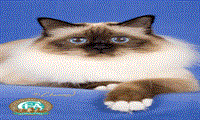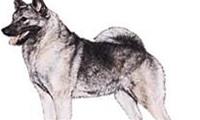
美國CFA官方關於挪威森林貓的品種介紹的中文翻譯版本和英文原版。
歷史起源
該貓祖先棲息在挪威森林中,
原 產 地
挪威
習 性
聰穎敏捷, 行動謹慎, 且能抓善捕, 善爬樹攀岩, 有“能幹的狩獵者”之美譽 繁殖方式 胎生

體部描述
軀體:身體各部肌肉發達, 骨骼粗壯頸部粗短, 脖上有蓬鬆的毛像裹了一圈圍巾。
頭 部:稍平的倒三角形
耳 朵:耳朵大而尖, 耳毛長, 可達3~4吋, 一直沿耳邊伸出
眼 睛:杏形而大的眼睛, 眼角稍吊
鼻 子:中等長度, 高鼻樑
四 肢:四肢有力, 後肢稍長, 並且後肢上被毛密生, 像穿了一條燈籠褲般
足 掌:腳爪靈活
尾 巴:尾巴壯麗, 若梳理得宜的話, 毛髮可展開達直徑12吋或更多。
披 毛:長而隨風飄動的毛, 柔軟如絲質般, 圍頸的鬃毛, 長而且濃密
毛 色
毛的顏色及圖案很多元化, 由純白色到深炭黑色, 可以是任何的圖案及顏色配搭, 但卻沒有重點色。 淡色的貓有著較厚的底毛, 而深色的貓卻有著較薄的底毛, 因為它們可以吸收陽光來保暖;有些顏色更是會隨季節的轉變而由淡變深。
中等長度的外層被毛可防雪避雨。 領毛較為豐富。 外觀與緬因貓相似, 有人將其西伯利亞森林貓同列.森林貓生長的環境非常寒冷和惡劣, 因此它長有比其他貓更厚密的被毛和強壯的體格.森林貓體大肢壯, 奔跑速度極快, 不怕日曬雨淋, 行走時頸毛和尾毛飄逸, 非常美麗.石般的眼睛鑲以金色的捆邊, 這便是每次吸引你看它的原因。

CFA對挪威森林貓的評分標準如下:
頭部 50分
鼻子輪廓 10分
咀部 10分
耳朵 10分
眼形 5分
耳朵位置 5分
頸 5分
下巴 5分
身體 30分
軀幹 10分
腿 / 腳 10分
骨骼 5分
尾巴 5分
毛髮長度 / 質地 5分
顏色 / 圖案 5分
狀態 5分
整體配合 5分
CFA官方網站關於挪威森林貓的品種介紹的英文原文:
Breed Profile: Norwegian Forest Cat
Bright emerald green eyes with a band of gold. Long flowing hair. Sweet-expressioned faces. Jaunty ear and toe trimmings. Each time you see a Norwegian Forest Cat is a feast for the eyes. Each time you touch their spun-silk soft coats is a delight to the fingertips.
These are the cats that explored the world with the Vikings, protecting the grain stores on land and sea, and which are believed to have left their progeny on the shores of North America as a legacy to the future.
These lovely cats are really two for the price of one, they can differ so greatly in looks from summer to winter. Some time in the spring they take off their “winter underwear,” the downy undercoat that provides warmth, and the long non-tangling outer guardhairs that act as protection from rain and snow. The contrast can be quite extreme. The inner-ear hair that deflects the wind and snow (and can be three to four inches long, curving out and around the ear like flexible racing stripes) remains all year. The tail is always magnificent, being as much as twelve inches or more when fanned to its fullest. Perhaps the most impressive part of the coat is the mane. On a fully mature cat, i.e. one over five years of age and which is challenged by the most adverse cold weather, the mane is nothing less than spectacular. It is long, dense and very, very impressive! This, unfortunately, may disappear in the spring, but rest assured that it will begin to lengthen again as the days begin to shorten.
These cats are designed by Mother Nature. They appear in coats of most colors, from pure white to deepest coal black, with every possible coat pattern and color combination in between, with the exception of the colorpoint colors as seen in the Siamese or Persian-Himalayan such as seal point or chocolate point. Darker cats require less coat to keep warm since they absorb more heat from the sun. Lighter cats tend to have fuller coats with more undercoat. Some colors change from light to darker tones with the seasons. Mother Nature is so thoughtful! And, finally, because they are a natural breed, their mature size will differ from line to line.
Is their Norse name accurate? Yes, the skogkatt, meaning forest cat, really did come out of the Scandinavian forests some time in the last 4,000 years. However, they are not feral but are among the most people-oriented cats. Of course their personalities differ, depending upon the type home in which they spend their early kittenhood. As with any other breed, a kitten handled and petted by many loving people from birth and which has been exposed to children, cats and dogs will be different from one born and raised in an isolated area with limited human contact.
A question frequently asked is about the care the long coats require. As one breeder is fond of saying: “Mother Nature does not have hairdressers in the deep woods, so she did not design the cat to require the daily attention necessary to some other longhaired breeds.” Very little, if any, combing is required for non-show cats, but is recommended during spring shedding.
The Forest Cat was presented to the CFA Board for registration acceptance in February 1987, and in 1993, these wonderful works of art from nature were accepted for full championship status.
Pricing on Norwegian Forest Cats usually depends on type, applicable markings and bloodlines distinguished by Grand Champion (GC), National or Regional winning parentage (NW or RW) or of Distinguished Merit parentage (DM). The DM title is achieved by the dam (mother) having produced five CFA grand champion/premier (alter) or DM offspring, or sire (father) having produced fifteen CFA grand champion/premier or DM offspring. Usually breeders make kittens available between twelve and sixteen weeks of age. After twelve weeks, kittens have had their basic inoculations and developed the physical and social stability needed for a new environment, showing, or being transported by air. Keeping such a rare treasure indoors, neutering or spaying and providing acceptable surfaces (e.g. scratching posts) for the natural behavior of scratching (CFA disapproves of declawing or tendonectomy surgery) are essential elements for maintaining a healthy, long and joyful life.
There are CFA clubs devoted to the promotion, protection and preservation of the Norwegian Forest Cat breed. For more information, please send inquiries to CFA, PO Box 1005, Manasquan NJ 08736-0805.
整體配合 5分
CFA官方網站關於挪威森林貓的品種介紹的英文原文:
Breed Profile: Norwegian Forest Cat
Bright emerald green eyes with a band of gold. Long flowing hair. Sweet-expressioned faces. Jaunty ear and toe trimmings. Each time you see a Norwegian Forest Cat is a feast for the eyes. Each time you touch their spun-silk soft coats is a delight to the fingertips.
These are the cats that explored the world with the Vikings, protecting the grain stores on land and sea, and which are believed to have left their progeny on the shores of North America as a legacy to the future.
These lovely cats are really two for the price of one, they can differ so greatly in looks from summer to winter. Some time in the spring they take off their “winter underwear,” the downy undercoat that provides warmth, and the long non-tangling outer guardhairs that act as protection from rain and snow. The contrast can be quite extreme. The inner-ear hair that deflects the wind and snow (and can be three to four inches long, curving out and around the ear like flexible racing stripes) remains all year. The tail is always magnificent, being as much as twelve inches or more when fanned to its fullest. Perhaps the most impressive part of the coat is the mane. On a fully mature cat, i.e. one over five years of age and which is challenged by the most adverse cold weather, the mane is nothing less than spectacular. It is long, dense and very, very impressive! This, unfortunately, may disappear in the spring, but rest assured that it will begin to lengthen again as the days begin to shorten.
These cats are designed by Mother Nature. They appear in coats of most colors, from pure white to deepest coal black, with every possible coat pattern and color combination in between, with the exception of the colorpoint colors as seen in the Siamese or Persian-Himalayan such as seal point or chocolate point. Darker cats require less coat to keep warm since they absorb more heat from the sun. Lighter cats tend to have fuller coats with more undercoat. Some colors change from light to darker tones with the seasons. Mother Nature is so thoughtful! And, finally, because they are a natural breed, their mature size will differ from line to line.
Is their Norse name accurate? Yes, the skogkatt, meaning forest cat, really did come out of the Scandinavian forests some time in the last 4,000 years. However, they are not feral but are among the most people-oriented cats. Of course their personalities differ, depending upon the type home in which they spend their early kittenhood. As with any other breed, a kitten handled and petted by many loving people from birth and which has been exposed to children, cats and dogs will be different from one born and raised in an isolated area with limited human contact.
A question frequently asked is about the care the long coats require. As one breeder is fond of saying: “Mother Nature does not have hairdressers in the deep woods, so she did not design the cat to require the daily attention necessary to some other longhaired breeds.” Very little, if any, combing is required for non-show cats, but is recommended during spring shedding.
The Forest Cat was presented to the CFA Board for registration acceptance in February 1987, and in 1993, these wonderful works of art from nature were accepted for full championship status.
Pricing on Norwegian Forest Cats usually depends on type, applicable markings and bloodlines distinguished by Grand Champion (GC), National or Regional winning parentage (NW or RW) or of Distinguished Merit parentage (DM). The DM title is achieved by the dam (mother) having produced five CFA grand champion/premier (alter) or DM offspring, or sire (father) having produced fifteen CFA grand champion/premier or DM offspring. Usually breeders make kittens available between twelve and sixteen weeks of age. After twelve weeks, kittens have had their basic inoculations and developed the physical and social stability needed for a new environment, showing, or being transported by air. Keeping such a rare treasure indoors, neutering or spaying and providing acceptable surfaces (e.g. scratching posts) for the natural behavior of scratching (CFA disapproves of declawing or tendonectomy surgery) are essential elements for maintaining a healthy, long and joyful life.
There are CFA clubs devoted to the promotion, protection and preservation of the Norwegian Forest Cat breed. For more information, please send inquiries to CFA, PO Box 1005, Manasquan NJ 08736-0805.
